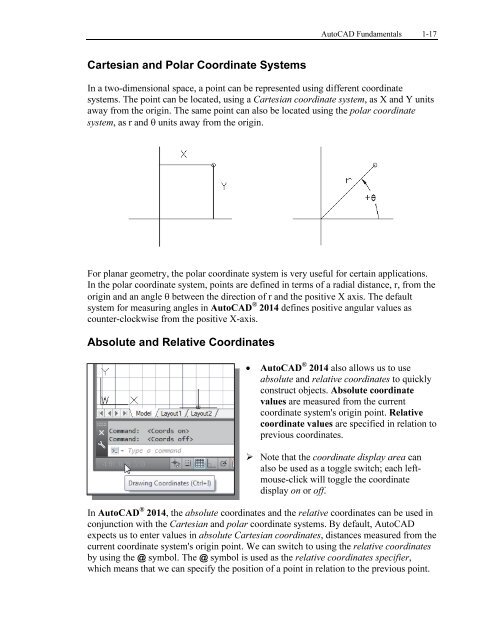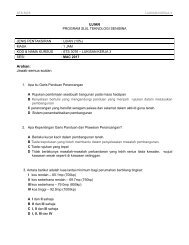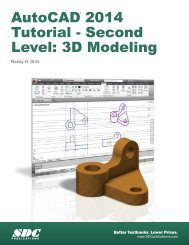Asas Autocad 2D
You also want an ePaper? Increase the reach of your titles
YUMPU automatically turns print PDFs into web optimized ePapers that Google loves.
AutoCAD Fundamentals 1-17<br />
Cartesian and Polar Coordinate Systems<br />
In a two-dimensional space, a point can be represented using different coordinate<br />
systems. The point can be located, using a Cartesian coordinate system, as X and Y units<br />
away from the origin. The same point can also be located using the polar coordinate<br />
system, as r and θ units away from the origin.<br />
For planar geometry, the polar coordinate system is very useful for certain applications.<br />
In the polar coordinate system, points are defined in terms of a radial distance, r, from the<br />
origin and an angle θ between the direction of r and the positive X axis. The default<br />
system for measuring angles in AutoCAD ® 2014 defines positive angular values as<br />
counter-clockwise from the positive X-axis.<br />
Absolute and Relative Coordinates<br />
• AutoCAD ® 2014 also allows us to use<br />
absolute and relative coordinates to quickly<br />
construct objects. Absolute coordinate<br />
values are measured from the current<br />
coordinate system's origin point. Relative<br />
coordinate values are specified in relation to<br />
previous coordinates.<br />
Note that the coordinate display area can<br />
also be used as a toggle switch; each leftmouse-click<br />
will toggle the coordinate<br />
display on or off.<br />
In AutoCAD ® 2014, the absolute coordinates and the relative coordinates can be used in<br />
conjunction with the Cartesian and polar coordinate systems. By default, AutoCAD<br />
expects us to enter values in absolute Cartesian coordinates, distances measured from the<br />
current coordinate system's origin point. We can switch to using the relative coordinates<br />
by using the @ symbol. The @ symbol is used as the relative coordinates specifier,<br />
which means that we can specify the position of a point in relation to the previous point.
















